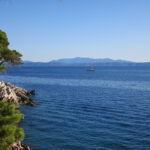If you’ve spent some time around the beautiful shores of the Mediterranean Sea, or you are thinking of visiting in the future, then you’ve probably noticed that there are a lot of stones and pebbles to be found. So, why are Mediterranean beaches so rocky?

Many Mediterranean beaches are rocky because of the erosive forces that occur on the often hilly coasts. In addition, fine sand particles tend to be carried away by waves in winter.
Read on to discover more about the stony beaches of the Med and how they came to be!
Why Are Some Beaches Rocky And Some Beaches Sandy?
Although we might think of all beaches as essentially the same thing, they are actually formed in many different ways – and constructed from a number of different things.
Fundamentally, beaches are a collection of sediment that is piled up where a large body of water meets the land, but that sediment can take several different forms. It is typically a mixture of sand, small stones, seashells, seaweed, and small marine organisms.
The difference between rocky and sandy beaches is in the size of the particles, and this is related to the material that they are made from, how they are deposited, and the type of erosion they are exposed to. Most rocky Mediterranean beaches are close to coastal cliffs where the stones fall from, and appear where the waves and wind can be intense.
How Sandy Beaches Form
You get a sandy beach when the material has been worn down significantly over time through low-energy waves, allowing large amounts of very small particles to build up. The tide and the current cause the particles to run over each other, carrying lightweight sediment from elsewhere as well as slowly eroding the small pieces down to a smaller size.
When the water is calmer and less energetic, it allows sand to be brought up to the surface without being carried back out to sea. This is why many sandy beaches appear in areas where the waves are not too intense.
Sandy beaches are actually the most common form of beach in the world and can be found all over the globe. They generally have a gently sloping profile which allows the waves to travel quite far up the beach itself, which means more sand can be layered on top.
How Rocky Beaches Form
You get a rocky beach when larger pieces of stone are present, usually deposited from a cliff face near the shore. These rocks then cause the waves to lose their power more quickly and prevent them from traveling far up the beach, which means that small particles (like sand) can’t build up as easily.
Rocky beaches also result from very energetic wave and wind systems. These stronger ocean movements will deposit larger rocks but smaller particles are held in suspension before being carried away to calmer waters. The rocks won’t get carried away by the tide, and then they will stop any sand from being left behind as well.
The rocks on these beaches are quite heavy, so they don’t move as much when they do interact with the water. They still get worn down slightly by the motion of the waves, but the process is much slower, and they don’t reach the minute size that you see with sand.
Why Does The Mediterranean Have So Many Rocky Beaches?
The reason why many Mediterranean countries have a high number of rocky beaches is due to the kind of coastline that is typically present, and the power of the waves.
The geology of the Mediterranean coast is generally made up of rocky cliffs and stony landscapes. It is a surprisingly hilly and mountainous region because of the way the area was formed.
Essentially, two large tectonic plates – from the African-Arabian continent and the Eurasian continent – came together, pushing up the huge Alpine Mountain system that ranged from the Pyrenees to the Zagros. This resulted in many cliffs and rock formations, and a strong stone foundation for many islands and coastal areas.
Additionally, the waters of the Mediterranean can be pretty intense, with strong winds and energetic waves. In these areas, sand gets carried away from the shoreline and isn’t able to build up over time, whereas large stones are broken down slowly and deposited on the beaches.
Are There Sandy Beaches In The Mediterranean?
Although many of the beaches around the Mediterranean coastline are certainly pretty rocky, that doesn’t mean that you won’t find sandy beaches as well.
Where the coastline has a gentle slope, the waters are relatively calm, and there aren’t large rocky deposits in the way, then beautiful golden sand will line the shore. In fact, almost every country around the Mediterranean Sea will have some sandy beaches, or at least beaches that have a combination of small stones alongside finer sand.
Italy, Spain, Greece, Turkey, Croatia, and many more countries are rich with sandy beaches that are perfect for a day in the sun.
How Do You Know What A Beach Is Made From?
Around the world, we see all kinds of beaches, from white sand to hard dark rocks. Interestingly, the color of the sand on a beach can usually give you a pretty clear idea of the type of material it is actually made from.
- White Sand: Usually quartz and limestone, potentially feldspar and gypsum.
- Light-Colored Sand: Mostly quartz and iron.
- Tropical White Sand: Calcium carbonate from the shells and skeletons of marine organisms.
- Pink Sand: Calcium carbonate with fragments of coral.
- Black sand: Volcanic rock, like obsidian or basalt.
- Red sand: Oxidated iron from volcanic rock.
- Orange sand: Includes iron deposits, usually combined with limestone, crushed shells, and volcanic rock.
Summary: Why Are Mediterranean Beaches So Rocky?
So, why is it that the beaches of the Mediterranean are so rocky? Well, it’s all to do with the materials present, the way the water moves, and the coastal landscape.
Larger stone deposits build up on beaches that are below rock formations, as they fall down from the cliffs above before being worn down by the waves. They also occur in areas where the wind and waves are more intense, as this stops sand from building up.
At the end of the day, though, rocks are not all you will see along the Mediterranean coastline. There are many sandy beaches as well, and both kinds offer their own beauty and charm.
- The Top Restaurants Specializing in Truffle Dishes - August 10, 2023
- Truffle Panna Cotta: A Decadent Dessert Recipe for Truffle Lovers - August 7, 2023
- Truffle Scrambled Eggs: A Luxurious Breakfast Delight - August 7, 2023








